Oral
Acquisition, Reconstruction & Analysis
Tuesday, 25 April 2017
| Room 310 |
16:15 - 18:15 |
Moderators: Brian Hargreaves, Tolga Cukur |
Slack Channel: #s_acq_recon_analysis
Session Number: O66
16:15
|
0570.
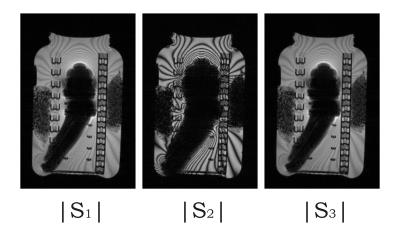 |
A Fourier Approach to bSSFP Debanding with 3 Phase-Cycled Acquisitions 
Qing-San Xiang
The highly efficient balanced Steady-State Free Precession (bSSFP) sequence has many research and clinical applications. However, it has a peculiar sensitivity to magnetic field inhomogeneity, often resulting in artifacts seen as dark bands. Phase-cycling can generate multiple acquisitions in which the banding is spatially shifted, and subsequently reduced by various algorithms. With 4 acquisitions and an elliptical signal model, it is possible to eliminate the banding by solving the system geometrically, algebraically, or in a combined manner for improved SNR. This work reports a Fourier approach that can effectively reduce the banding using only 3 acquisitions.
|
16:27
 |
0571.
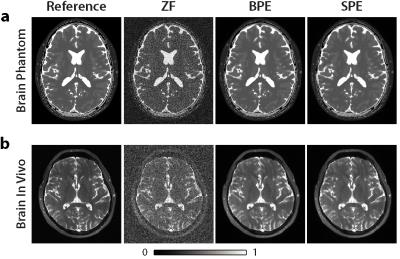 |
Parameter-Free Profile Encoding Reconstruction for Multiple-Acquisition bSSFP Imaging 
Efe Ilicak, Tolga ăukur
Several recent studies suggested accelerating multiple-acquisition balanced steady-state free precession acquisitions to suppress banding artifacts while maintaining scan efficiency. However, these approaches employ regularization terms, which require labor-intensive manual tuning of penalty weights. Here, we propose a parameter-free framework to select penalty weights adaptively for profile-encoding reconstructions. Results indicate the proposed method achieves equivalent image quality to conventional reconstructions, without an exhaustive manual tuning of penalty weights.
|
16:39
 |
0572.
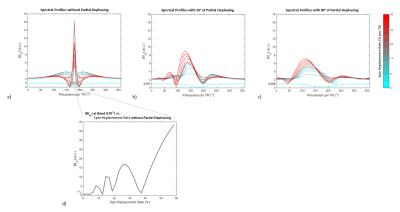 |
Mitigation of bSSFP Flow Artifacts using Partial Dephasing 
Anjali Datta, Joseph Cheng, Corey Baron, Dwight Nishimura
We show that partial dephasing mitigates artifacts from through-plane flow near dark bands in balanced SSFP. A 30o-60o range in the phase accrual during a TR is created over the voxel by slightly unbalancing the slice-select rephaser. The effects of partial dephasing on the spectral profiles for various flow rates were simulated, and the simulations were validated in a flow phantom. By decreasing the strength and non-linearity of the signal’s dependence on through-plane flow rate, partial dephasing mitigates the transient artifacts caused by pulsatile flow. In volunteer studies, it noticeably decreased artifacts in all of the phase-cycled cardiac cine datasets acquired.
|
16:51
|
0573.
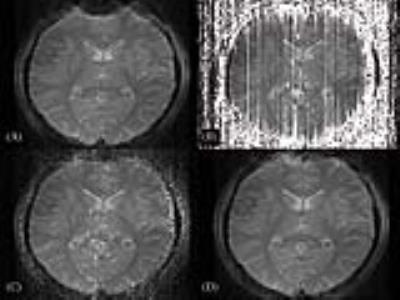 |
Correction of Susceptibility-Related Image Distortion Based on an Analytic Point-Spread Function 
Franz Patzig, Toralf Mildner, Harald M÷ller
Geometric distortions caused by magnetic susceptibility variations in the underlying medium can severely corrupt the image. A novel correction method is proposed, which uses the prior knowledge of the analytic point spread function (PSF) of the used imaging sequence and a map of the underlying field inhomogeneities. From this input, a PSF operator can be devised and applied to correct the image by performing a deconvolution. Regularization techniques are used to improve and stabilize the outcome. A significant reduction in geometric distortions is demonstrated for human brain images as well as some advantages over existing correction methods.
|
17:03
 |
0574.
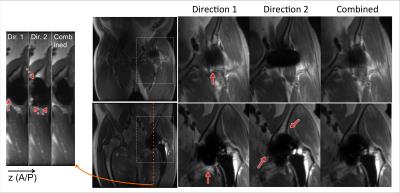 |
Pile-up and Ripple Artifact Correction Near Metallic Implants by Alternating Gradients 
Xinwei Shi, Brady Quist, Brian Hargreaves
Multi-Spectral Imaging techniques have been shown to significantly reduce metal-induced artifacts. However, they often suffer from residual pile-up and ripple artifacts in the vicinity of metal, where the metal-induced off-resonance gradient “cancels” the frequency-encoding gradient. Fully phase-encoded methods can overcome the drawbacks of frequency encoding, but usually incur prohibitively long scan times. Here we address this limitation by combining two acquisitions with alternating-sign readout and slice-select gradients. We demonstrate with simulations, phantom and in-vivo scans that the proposed method can effectively suppress pile-up and ripple artifacts, and reduce the signal loss areas near the implants.
|
17:15
 |
0575.
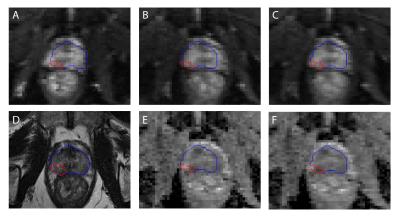 |
Geometric Distortion Correction of Diffusion-Weighted MRI and its Effect on quantitative ADC analysis 
Gabriel Nketiah, Kirsten SelnŠs, Elise Sandsmark, Jose Teruel, Tone Bathen, Mattijs Elschot
Tissue water diffusion (ADC) quantification through diffusion-weighted imaging (DWI) currently plays an integral clinical role in prostate cancer. The echo-planar imaging technique employed in DWI is however prone to geometric distortion due to static magnetic field (B0) inhomogeneity. We investigated the effect of the correction of this distortion on the quantification of ADC values in the prostate. Our study showed that there is a significant association between the amount of distortion (mm) and the difference between ADC values before and after correction, which implies that correction for this could be necessary, especially for voxel-based quantitative analysis.
|
17:27
|
0576.
 |
Estimating and eliminating excitation errors in bipolar gradient composite excitations caused by RF-gradient delay: example of bipolar spokes pulses in parallel transmission 
Desmond H Y Tse, Christopher J Wiggins, Benedikt A Poser
Parallel transmission of spokes pulses is a promising way of mitigating flip-angle inhomogeneity in 2D imaging at ultra-high-field MRI. Bipolar slice-selective gradient is often used to minimise the overall duration of these pulses, making them more resilient to off-resonance related artefacts, but they are prone to errors caused by RF-gradient timing mismatch. In this study, we present a mathematical description for the effect of such delay on bipolar-gradient composite excitations. We demonstrate the effect with both flip-angle maps and EPI images. Finally, we propose a navigator approach to estimate the delay and show two effective ways of eliminating these errors.
|
17:39
 |
0577.
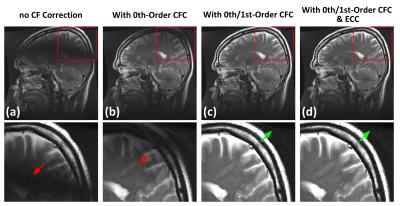 |
Effect of Concomitant Field in Fast Spin Echo Acquisition on an Asymmetric MRI Gradient System 
Shengzhen Tao, Paul Weavers, Joshua Trzasko, Yunhong Shu, Erin Gray, John Huston III, Matt Bernstein
Fast-spin-echo (FSE) acquisitions are routinely used in clinical MRI, but can be affected by concomitant field (CF)-induced phase errors. The conventional whole-body MR gradient typically employs symmetric design. On such systems only CFs of 2nd-order spatial dependence are significant. These CFs can cause ghosting in large-FOV FSE acquisition, but are typically negligible over a brain scan volume. Recently, a high-performance, asymmetric gradient system was developed whose CF contains additional zeroth and first-order spatially-dependent fields. Here, we investigate the effect of CF in FSE on this system using extended-phase-graphs simulation, and demonstrate a real-time compensation for them.
|
17:51
|
0578.
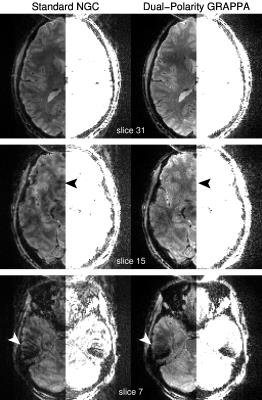 |
Artifact Correction in Accelerated-Segmented EPI data via Dual-Polarity GRAPPA 
W. Hoge, Jonathan Polimeni
A method to reconstruct images from multiple EPI segments in presented. Leveraging the reconstruction framework from Dual-Polarity GRAPPA, data from each segment and readout polarity are modeled as sampled on separate grids. After phase-matching calibration data to each segment, a GRAPPA-like reconstruction kernel is generated. This parameterization ensures that differences in signal phase across all data polarities and segments can be captured in the reconstruction kernel. We present in-vivo images reconstructed using this approach from concurrently segmented and accelerated high-resolution gradient-echo and spin-echo data acquired at 7T.
|
18:03
|
0579.
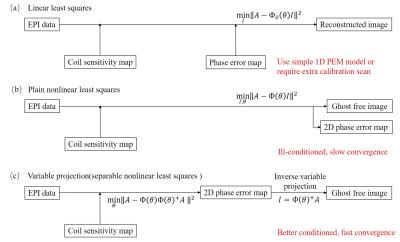 |
Variable Projection SENSE for Reference-free EPI Nyquist Ghost Correction - permission withheld
Yue Zhang, Mengye Lyu, Yilong Liu, Yifan Chen, Ed Wu
In this abstract, variable projection sensitivity encoding (VP-SENSE) method is proposed to correct phase error, which is the main cause of Nyquist ghost in EPI. In VP-SENSE, the unknown images are fully represented by a function of phase error and the least squares solution is sought regarding phase error only. Our results have indicated that this approach can robustly remove ghost without apparent SNR penalty. With prior phase error information as constraints, ghost level can be further reduced and the SNR loss can be further minimized through constrained variable projection approach (CVP-SENSE).
|
|












